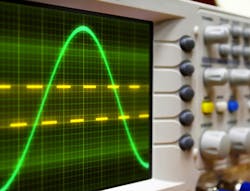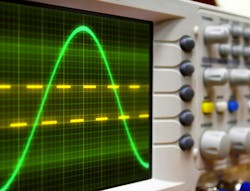Scopes Are Essential at Any Frequency
RF/microwave engineers have been spoiled somewhat by the modern test bench, with highly accurate and programmable test signal sources, spectrum analyzers, and vector network analyzers (VNAs), and even personal computer (PC) software to coordinate high-frequency measurements. But anyone who can remember taking the rear panel off an old radio and starting the search for “dead spots” in the circuit with a voltmeter probably also recalls the first time they sat in front of an oscilloscope on a test bench.
It was an analog instrument back then, and oscilloscopes are now based on digital sampling and memory storage of waveforms, but the feeling that an oscilloscope brings to electronic measurements is much like that from a voltmeter. The feeling is of being “close” to the circuit under test and truly understanding the effects of the resistors, capacitors, and inductors on the circuits and even the dielectric material on the transmission lines at higher frequencies. Modern scopes may now be computerized and digital like many other test instruments, but the information they can reveal about a circuit under test is still invaluable to the users who take the time to appreciate their many capabilities.
Perhaps due to the relative maturity of these instruments, modern digital storage oscilloscopes (DSOs) may provide as much value in terms of measurement capability per dollar as any high-frequency electronic test instrument. Under $2,000 brings a portable instrument with two or four channels and typical 100 to 200 MHz bandwidth and 1 GSamples/s sampling rate. At no time in history have engineers had such a wide choice of high-frequency oscilloscopes, with some capable of sampling input signals to 40 GHz and beyond.
Finding the Right Fit
There are many differences in current oscilloscope products, not just in physical sizes, from benchtop and modular units to handheld scopes, but in technologies, from older analog oscilloscopes to many variants of DSOs and sampling methods used in digital oscilloscopes. Users have often commented about differences in noise levels between analog oscilloscopes and DSOs, and even users of different types of new oscilloscopes have pointed out preferences for different types of sampling methods, such as real-time sampling or equivalent time sampling.
Measurements and applications differ widely, so there is no one best oscilloscope design for characterizing time-varying signals from RF through millimeter-wave frequencies. Many suppliers of oscilloscopes offer measurement software that allows tests to be controlled from a PC, sometimes with a connection as simple as a USB cable between the oscilloscope and the PC. But an oscilloscope in any format has long been a “hands-on” type of instrument and one that is typically used with one hand on a test probe and the other hand on the controls of the oscilloscope. While instruments like spectrum analyzers and VNAs lend themselves to automated, repetitive measurements, an oscilloscope is a troubleshooting tool, an instrument that has always been a good match for measuring the unknown. Equipped with sufficient bandwidth and vertical resolution, an oscilloscope can “find” signals that may or may not be within a circuit or device under test, such as intermittent signals or short-duration pulses.
Every RF engineer may not need a spectrum analyzer or a VNA, but an oscilloscope is invaluable for quick checks and troubleshooting. There is no single “best” oscilloscope for any particular user since application requirements vary widely even just in terms of bandwidth and sampling rates. Much like a PC, it is usually a matter of getting the best performance that is affordable at the time, knowing that it is a mature marketplace for oscilloscopes with many fine-performing instruments available with excellent value for their costs.
About the Author
Jack Browne Blog
Jack Browne, Technical Contributor, has worked in technical publishing for over 30 years. He managed the content and production of three technical journals while at the American Institute of Physics, including Medical Physics and the Journal of Vacuum Science & Technology. He has been a Publisher and Editor for Penton Media, started the firm’s Wireless Symposium & Exhibition trade show in 1993, and currently serves as Technical Contributor for that company's Microwaves & RF magazine. Browne, who holds a BS in Mathematics from City College of New York and BA degrees in English and Philosophy from Fordham University, is a member of the IEEE.


